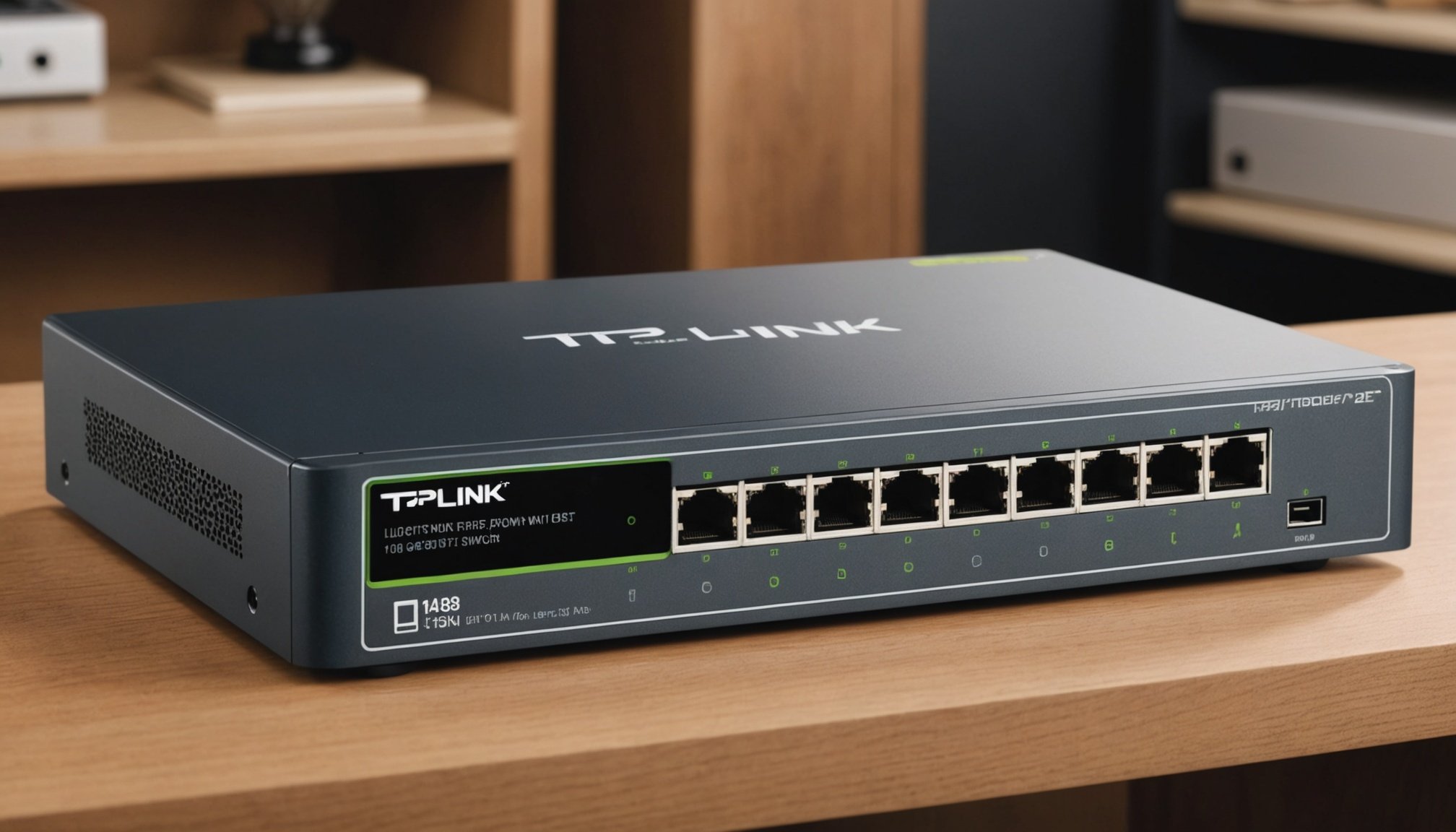Overview of 10GbE Networking
The rise of 10GbE networking marks a significant leap in data transfer capabilities for both small businesses and home networks. 10GbE (10 Gigabit Ethernet) provides a solid foundation for a high-speed network, offering ten times the speed of traditional Gigabit Ethernet. This advancement facilitates seamless data exchange and efficiently supports bandwidth-intensive applications.
High-speed networks, like those utilizing 10GbE, drastically reduce latency and improve the overall performance of network-dependent tasks. This is particularly beneficial in environments where rapid data transfer or real-time communication is essential, such as media production, gaming, or operating multiple servers. For small businesses, a 10GbE network can enhance productivity by supporting quicker access to large files and improving the performance of cloud-based applications.
Introducing the TP-Link TL-SX1008, an essential component in building a robust 10GbE network. This switch supports eight ports, allowing for a multitude of devices to connect and communicate with optimal efficiency. It is designed to handle intensive workloads without compromising network speed.
By incorporating a switch like the TP-Link TL-SX1008, users can maintain high-level network performance, achieving the full potential of a 10GbE network. The switch’s efficient power management and ease of use make it an ideal choice for those aiming to upgrade their current networking infrastructure.
Also to read : Comprehensive guide to crafting a powerful 3d rendering workstation featuring the amd threadripper 3960x
Preparing for Installation
Setting up a network efficiently starts with thorough network setup planning and consideration of future expansion needs. Begin by analyzing your current requirements while keeping an eye on potential growth. This ensures your network remains scalable, adapting alongside your demands.
Installation Checklist
A comprehensive installation checklist is crucial for a smooth process. Gather and verify necessary components, including:
- Routers and switches for connectivity and management.
- Cabling suitable for your environment and bandwidth needs.
- High-quality network interfaces for all devices.
These equipment requirements form the backbone of your network, facilitating reliable and robust connectivity.
Safety and Workspace Setup
Prioritize safety precautions while organizing your workspace. Ensure that all cables are neatly arranged to prevent tripping hazards, and surfaces are clear of obstructions. Regularly inspect equipment for any wear and tear as well.
Additionally, maintain a well-lit and organized environment, making it easier to access and identify components when necessary. Proper workspace setup not only enhances safety but also contributes to smoother operation and maintenance of the network. Remember, planning thoroughly at this stage can prevent complications later on and ensure seamless connectivity and performance.
Unboxing and Physical Setup of TP-Link TL-SX1008
Setting up the TP-Link TL-SX1008 begins with a straightforward unboxing process. Remove the packaging carefully to reveal the contents: you’ll find the switch, a power cable, an installation guide, and a mounting kit. Make sure everything listed in the guide is present.
Unboxing the TP-Link TL-SX1008
Opening the box is simple. Ensure that all components are intact and read through the installation guide. The switch setup primarily involves connecting the power cable and following the step-by-step instructions provided.
Analyzing Switch Ports and Indicators
The switch features eight 10G ports, each marked clearly for easy identification. The LED indicators are crucial for monitoring network activity. Understanding these can aid in troubleshooting. The connection status and speed are displayed via these LEDs, offering immediate feedback on performance.
Physical Placement and Mounting Options
Consider the physical installation and placement of your switch. Ensure it’s positioned in a well-ventilated area to prevent overheating. The switch can be mounted on a wall using the included kit or placed flat on a surface. Optimal placement is essential for maintaining efficiency and accessibility. Proper ventilation and avoiding crowded spaces will contribute to the longevity of the device.
Configuring the TP-Link TL-SX1008
Navigating the management interface of your TP-Link TL-SX1008 can seem daunting, but with a systematic approach, configuring the network settings becomes straightforward. Start by accessing the interface through a web browser. You’ll need the default gateway IP to log in. Once you’re in, you can adjust the IP configurations to better suit your network needs. Setting up a static IP can aid in maintaining a stable and reliable connection, reducing unexpected network interruptions.
The switch configuration also allows you to set up VLANs (Virtual Local Area Networks). VLANs effectively segment your network, improving both security and efficiency. Within the management interface, navigate to the VLAN settings, and create virtual networks that align with your operational requirements. This isolation ensures better management of network traffic and increases the overall security by restricting access to sensitive information.
For optimal performance, additional settings must be fine-tuned. Check the Quality of Service (QoS) settings to prioritize traffic that is crucial to your operations, ensuring bandwidth is used effectively. By carefully adjusting these settings, unnecessary network congestion can be minimized, enhancing the user experience. Each of these adjustments contributes significantly to the efficient operation of your TP-Link TL-SX1008, making it a powerful asset in your technology arsenal.
Optimizing Network Performance
To maintain optimal network performance, several strategies can be utilized. An essential aspect is monitoring network traffic and usage. This can be achieved through various tools designed to track data flow, identify congestion points, and ensure efficient operation. Monitoring helps in understanding which applications consume the most bandwidth, allowing administrators to make informed decisions.
Another critical aspect is adjusting Quality of Service (QoS) settings. QoS is vital for prioritizing certain applications, ensuring that critical operations receive the necessary bandwidth to function seamlessly. By configuring QoS, network administrators can allocate resources effectively, giving precedence to important services like VoIP or streaming, thus enhancing overall performance.
Running speed tests regularly is also crucial in assessing network performance. Speed tests measure download and upload speeds, helping to evaluate network efficacy comprehensively. Utilizing these tests aids in identifying bottlenecks and potential issues, allowing for timely resolution.
Understanding the results of these tests is indispensable. It helps in discerning whether the network meets performance expectations and identifying areas needing improvement. With these strategies – traffic monitoring, QoS adjustments, and speed testing – network performance can be optimized to ensure reliable and efficient communication across systems. Efficient application of these methods enhances both productivity and user satisfaction.
Troubleshooting Common Issues
Navigating network problems can be daunting but understanding common issues may help you solve them effectively. Connectivity issues often arise from simple errors. Start by checking if devices are properly connected to the network. An overlooked yet frequent cause of these problems is loose cables, so ensure all physical connections are secure.
When confronting switch malfunctions, observing power light indicators is crucial. No lights or unusual blinking patterns indicate an issue. First, ensure the switch is powered correctly. If the issue persists, try a restart, which can resolve many temporary glitches.
Resolving malfunctioning switches can be achieved by updating firmware to the latest version. This often eradicates bugs and enhances performance. Additionally, examine network configurations for misconfigured settings that could affect connectivity.
Sometimes, these measures may not resolve the issue. Seek professional assistance when you’ve exhausted common troubleshooting steps. Technicians not only provide solutions but also offer insights to prevent future complications.
To identify connectivity issues accurately, tools like network monitoring software can be invaluable. These help trace network paths and highlight inconsistencies, ensuring a more robust network health diagnosis.
Proactive maintenance, including regular equipment inspections, is often the key to sustaining network efficiency and avoiding disruptions.
Comparing TP-Link TL-SX1008 with Other Switches
When conducting a competitive analysis of the TP-Link TL-SX1008, it is essential to delve into the features and specifications that set it apart from other 10GbE switches. The TL-SX1008 is renowned for its robust design and eight 10-Gigabit ports, which cater to both small offices and network enthusiasts.
Many users appreciate its unmanaged switch design, which simplifies installation and operation, making it an attractive choice for less technically inclined individuals. Additionally, the passive cooling mechanism contributes to a noise-free environment, a feature not found in all competitors.
From a price-value perspective, the TL-SX1008 stands competitive. While there are more economical options available, such as some netgear or d-link models, these often compromise on the port count or management features. The TL-SX1008 balances cost with premium features, offering excellent value for its price point.
User feedback indicates high satisfaction with the switch’s reliability and consistent performance. Common praises highlight its ease of use and stable connections. User ratings across retail platforms generally reflect a positive consensus, though some suggest improvements in the device’s firmware for enhanced connectivity options.
In conclusion, the TP-Link TL-SX1008 leads in simplicity and quality, striking a fine balance against its competitors in both features and pricing.
User Testimonials and Case Studies
The journey from curiosity to satisfaction is filled with user experiences that attest to the transformative power of technological advancements. Real case studies offer us a glimpse into successful implementations, showcasing the tangible benefits experienced by users in diverse scenarios.
One noteworthy narrative details a family who integrated a smart home system to enhance security and convenience. The customer feedback highlighted the system’s ease of installation, which was surprisingly manageable even for technology novices. The family appreciated that the process required minimal professional intervention, illustrating a widespread sentiment of accessibility.
Performance feedback often revolves around the products’ reliability and efficiency. Users noted significant improvements in daily routines, with automation reducing time spent on mundane tasks. For many, this meant more quality time with family, as opposed to lingering chores.
Lessons learned from these user experiences are invaluable. Stories often highlight the importance of understanding one’s needs before selecting technology solutions. This awareness helps in choosing devices that best fit the users’ lifestyles. Consequently, many users advise future buyers to research thoroughly and perhaps indulge in trial runs to ensure compatibility.
In conclusion, these user experiences illuminate the profound impact of modern solutions, encouraging others to make informed decisions, supported by genuine insights from fellow customers.
FAQs on 10GbE Networking
Navigating 10GbE setups can be daunting with the sheer volume of frequently asked questions. Let us tackle common concerns and provide clarity.
General inquiries about 10GbE networking
Many wonder why 10GbE is essential. Simply put, it offers ten times the bandwidth of traditional 1GbE networks, equipping businesses to handle data-heavy tasks efficiently. In terms of practical usage, 10GbE is indispensable for activities that require robust data transfer, such as media production or virtualised environments.
Technical questions about the TP-Link TL-SX1008
The TP-Link TL-SX1008 is a popular choice in 10GbE setups. A common technical inquiry involves its power consumption. Users report moderate energy use, which aligns with its industry role as a cost-effective switch for high-speed networking. This device has eight ports, allowing for widespread connectivity across various systems while maintaining optimal speed and reliability.
Recommendations for future networking upgrades
When considering future upgrades, look toward scalability and compatibility with emerging technologies. Optical network innovations, for example, promise higher bandwidths. Misconceptions like “10GbE isn’t necessary for smaller networks” often deter upgrades. However, future-proofing with 10GbE can keep network infrastructure adaptable and efficient as data demands grow. Exploring these options ensures your network is both responsive to current needs and ready for future advancements.











